Family : Elapidae

Text © Dr. Luca Tringali

English translation by Mario Beltramini
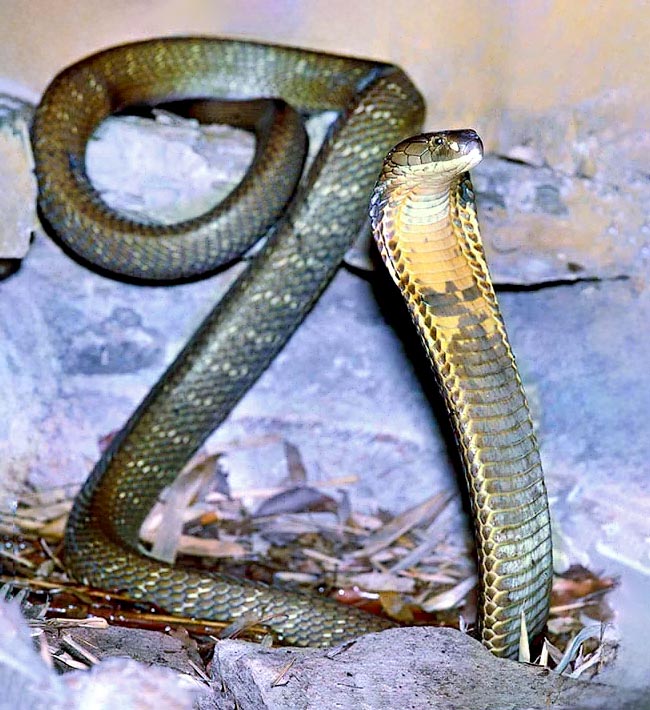
Almost 6 m long, King Cobra (Ophiophagus hannah) is the biggest venomous snake in the world © Giuseppe Mazza
The King Cobra, Ophiophagus hannah (Cantor, 1836), is a reptile of the family Elapidae, where is recorded the highest degree of adaptive radiation in the context of highly venomous snakes, that is the formation of many species ecologically differentiated starting from a common ancestor.
From the end of the Eocene the elapids would first have spread in Africa and in southern Asia to then expand their range in Australia, about 25 Ma.
To this family belong roughly 60 genera and 410 species, including the sea snakes of the subfamily Hydrophiinae, once assigned to a separate family.
At present, the elapids are widely distributed in Africa, Australia, from Southern United States to South America, and in many oceanic islands, especially in the tropical and subtropical regions and are completely absent in Europe.
This family includes some of the most venomous snakes in the world, and the species of particular medical relevance are found in southern and south-eastern Asia with the genus Ophiophagus (King Cobra or False Cobra), in Asia and in Africa with the genus Naja (True Cobras), in Sub-Saharan Africa with the two species of Mambas
Dendroaspis angusticeps and Dendroaspis polylepis, from Iran to eastern Asia with the genus Bungarus (Kraits) that shares part of the southern range of the King Cobra with the species Bungarus fasciatus, in Australia and New Guinea wit the genera Acanthophis (Death “Adders”) and Oxyuranus (Taipan), including one of the most venomous species in the world Oxyuranus scutellatus, from southern U.S.A. to central Argentina with the genera Micrurus and Micruroides (Coral Snakes), and in the tropical and subtropical Indo-Pacific belt with the sea genera Laticauda and Hydrophis, whose species Hydrophis elegans holds the depth record, 145 m, among the sea snakes.
Some species, especially in Australia, are too small for biting the man effectively, but all others may cause at least a certain degree of poisoning, to the point of being lethal.
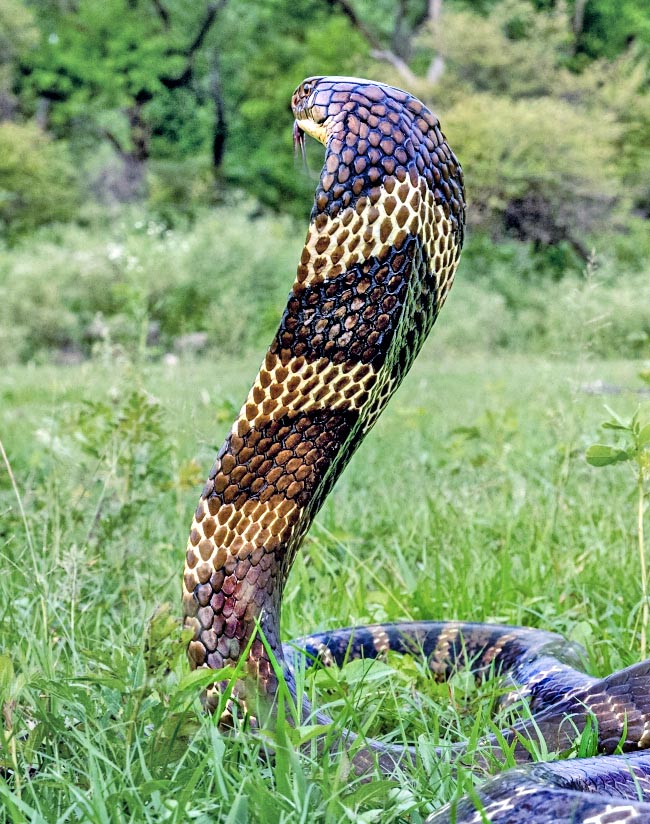
Unlike other cobras, the hood does not have fake eyes but two yellow or whitish lines shaped like an arrow © Daniel Liepack
The are all proteroglyphous, that is with fangs placed anteriorly on the jaw, from the Greek “πρότερος” (próteros), forward, and “γλυφή” (glifé), groove, capable of non-significant rotation, limited length of the fangs, that, in the species dangerous for man, may vary from 2 to 12 mm, rarely more, generally very large venom gland placed behind the eye.
Ophiophagus is still considered a monotypic genus with the only species, endemic to Asia, Ophiophagus hannah whose generic epithet, coming from the union of the Greek words “ὄφις” (ófis), snake and “φαγεῖν” (fagéin), to eat, well describes the eating habits of this reptile who feeds preferably on other snakes and lizards.
Conversely, the specific epithet could refer to its arboreal skills as it is traditionally derived from the fist part (Ama-) of the word Hamadryas, arboreal nymphs of Greek mythology. An alternative hypothesis might refer to the Hebrew “חנן” (hanan, hence the female name Hannah), be kind, or to beg, in relation to the extreme danger of the King Cobra.
Zoogeography
Ophiophagus hannah is an iconic reptile as, being able to reach a length of almost 6 m, is the biggest venomous snake in the world.
It is amply diffused through tropical, subtropical and temperate Asia, from eastern Pakistan to the southern Chinese coasts; it is present also in numerous tropical archipelagoes such as Indonesia, Philippines and Andaman Islands, but is absent, surprisingly, from Sri Lanka and from Taiwan.
The systematics of the King Cobra has evolved starting from Theodore Edward Cantor, Danish naturalist at the service of the East India Company and then assistant surgeon in the British Army in China during the First Opium War, who in 1836 this species with the name of Hamadryas hannah, hence Hamadryad, the other common name under which the reptile is known.
The genus Ophiophagus was created later on by the Anglo-German physician and zoologist Alber Carl Gotthilf Gûnther in 1864, and the species Ophiophagus hannah was formally recognized by the scientific community in 1945.
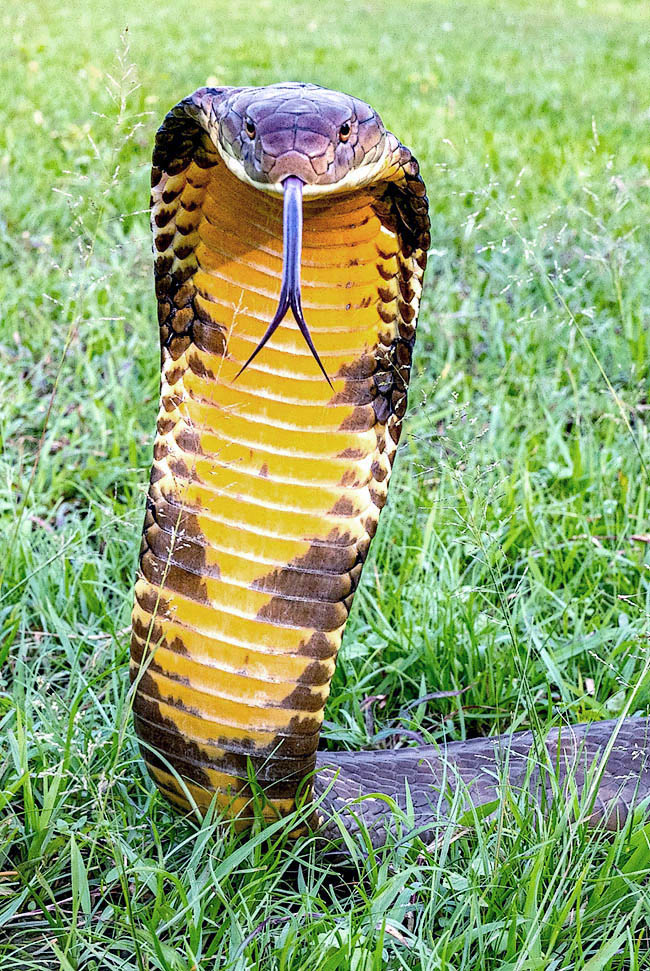
His vision, perceives badly the still objects but detects the moving ones even if 100 m far away © Daniel Liepack
Even if commonly indicated as King Cobra, Ophiophagus hannah is not a strictly speaking Cobra because it lacks numerous anatomical features characteristic of the genus Naja.
Recent genetic analyses suggest a stricter relationship with the Mambas of the genus Dendroaspis.
The King Cobra is presently the only recognized species of the genus Ophiophagus, although there is evidence of significant phylogenetic divergences within the species, like, for instance, between the northern and southern populations of Thailand.
Its distribution area discontinuous and characterized by many populations restricted to the wet areas and to the plain forests of continental Asia, the numerous populations of the islands and of the Indo-Pacific archipelagoes, the different ecological conditions where the populations live and the presence of many potential geographical barriers are all concurrent features that may have created favourable opportunities for the evolution of cryptic species, that is genetically different but so similar morphologically to be indistinguishable.
Strongly influenced by the availability of wet climate conditions, Ophiophagus hannah displays a somewhat enigmatic distribution model, as it is present in various archipelagoes and tropical islands but is absent in others, however showing apparently favourable climates.
This fact appears even more surprising due to the proximity of these islands to the mainland as well as due to the presence of these snakes in other archipelagoes more distant like the Philippines or the Andaman Islands.
Similarly, other biogeographical aspects are little understood, for instance if the species has had a continental origin and consequently has diffused in the archipelagoes of the Indo-Pacific or vice versa, the effect of the glacial cycles may have had on its genetic differentiation.
This last aspect might be two-fold: the glaciations may have facilitated the dispersion through the oceans via the formation of terrestrial bridges, but on the other hand might have reduced the interconnection between populations on the mainland because of a drastic reduction of the extension of the wet forests.
The reduction of suitable climate corridors when Taiwan and Sri Lanka were connected to the mainland, about 20.000 years ago, could explain the absence of the King Cobra from these islands.
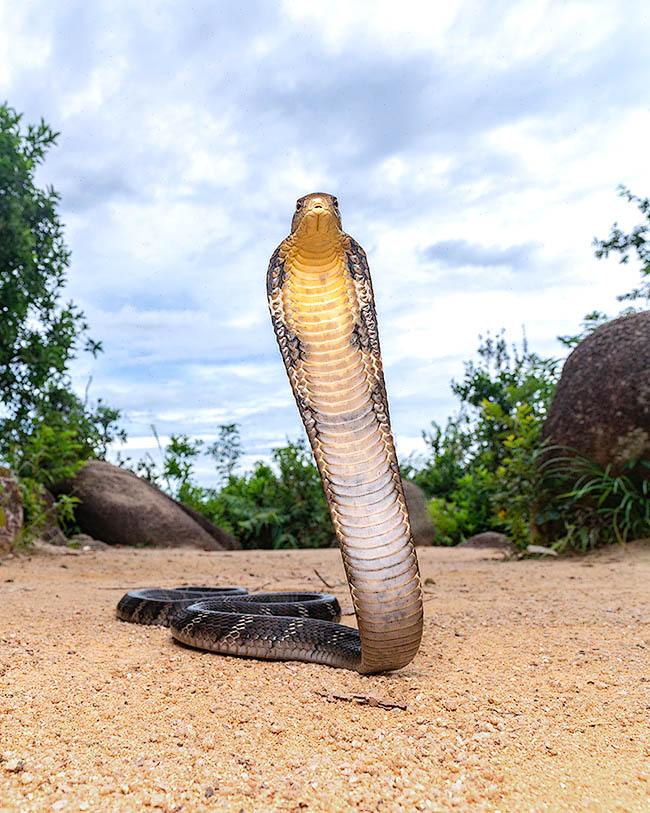
When feeling menaced Ophiophagus hannah can raise for about a third of the body , even more than one metre from the soil with lateral flattening of the back, hood expansion and terrifying dissuasive hisses © Lawrence Hylton
These fluctuations may have left a mark on the phylogenetic structure of the King Cobra, in support of the hypothesis that the genus Ophiophagus is not monotypic but rather is formed by a complex of species, aspect somewhat already predicted in the original Cantor’s description but late rejected by the following Authors.
It is in this sense that Ophiophagus hannah, in accordance with molecular and paleoclimatic data, can be subdivided in at least four groups quite distinct at morphological and genetic level, dating back to before the Pliocene (5,332-2,588 Ma), that in future may correspond to as many different species, and corresponding to the following geographical areas which constituted as many glacial refuges.
The first group is formed by populations distributed in the humid forests of low and medium altitude in the Western Ghats, from the Agasthyamalai hilly range to the south up to the Sindhudurg plateau to the north, in south-western peninsular India.
The most widely diffused group is distributed from the slopes of the Himalayas in north-western India and from the eastern peninsular India in south-west up to north-east and south-east of continental Asia, with isolated island populations in the Andaman Islands south; the southern limit still remains unclear in continental Asia, potentially corresponding to the Kra Isthmus, in the Malay Peninsula.
The third group is present in peninsular Malaysia and, through Sumatra, Java, Borneo, goes as far as Bali and Mindoro island in northern Philippines. The latter is confined to Luzon island, in the Philippines.
Ecology-Habitat
Ophiophagus hannah is found from the sea level up to 2300 m of altitude, in environments including broadleaf forests, tropical seasonal forests, mangrove swamps and tropical rainforests, often in anthropized areas, including cultivated fields and rural villages.
The ecological niche of this diurnal snake, but occasionally active also by night, seems determined by the quantity of rain, as its range is exclusively formed by very humid regions exceeding 1500 m of rain per year.
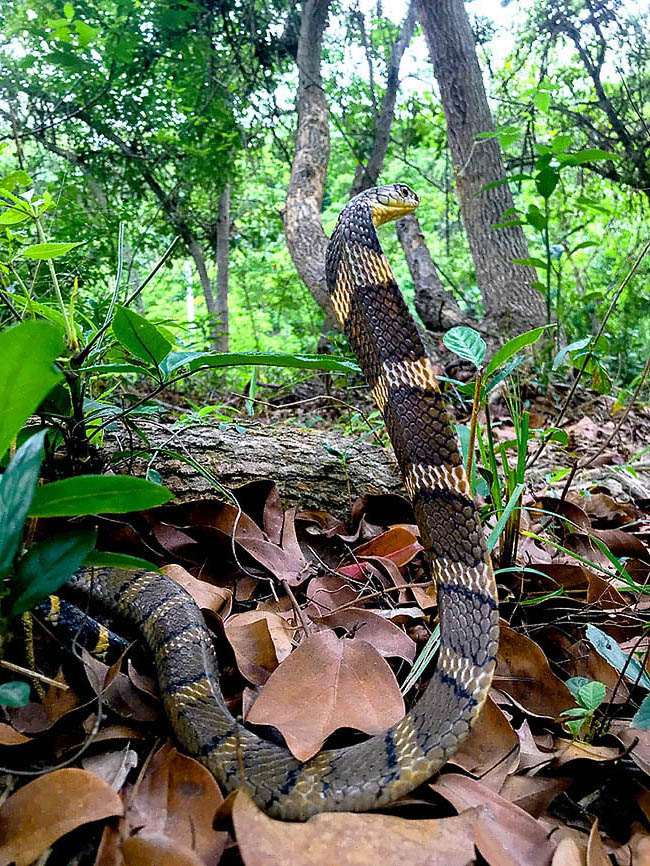
Usually active the day, King Cobra is diffused in tropical, subtropical and temperate Asia, from the sea level up to 2300 m of altitude, but only in the very humid region exceeding 1500 mm of rain per year © 鸿志
Such environmental requirements are related to the trophic specialization of this reptile who, as the generic epithet suggests, has a diet mainly formed by other snakes; the only other preys worthy of mention are the lizards of the genus Varanus.
In fact, the tropical humid habitats have a bigger availability of preys, with associations very rich in species of snakes as the interspecific competition is quite reduced because of the high availability of food in these environments.
The ophiophagy is a trophic specialization developed by the King Cobra who, due to the quantity of venom injected and to its size, can feed on venomous or very big species like the Reticulated Python (Malayopython reticulatus) or the Indian Rock Python (Python molurus).
When food is scarce it can feed on birds and mammals, but its choice prey is formed by the Oriental Rat Snake
(Ptyas mucosa), colubrid practically ubiquitous in Asia; observations on specimens equipped with radio transmitters show that many individuals develop a very strict diet relative to a single species of snake, refusing any alternative prey.
Ophiophagus hannah, is an active predator, able to swim, that looks for prey moving easily on the ground as well as on the trees, even over 20 metres high, with continuous tongue strokes for constantly probe cracks, hideouts, stumps and piles of vegeal debris, and trying to catch chemical-odorous signals that are then transferred to the Jacobson’s organ, sensory receptor placed in the upper part of the mouth.
The predation activity requires an average research effort of 3,5 hours per day for average daily movements of more than 250 m in the adult males, within a “home range” area of use of about 800 ha during the reproductive season and 500-600 ha outside this one.
As soon as an odorous track has been noted, even during heavy rains, the activity of the King Cobra gets more intense, including the swing of the head and increasingly more frequent tongue strikes.
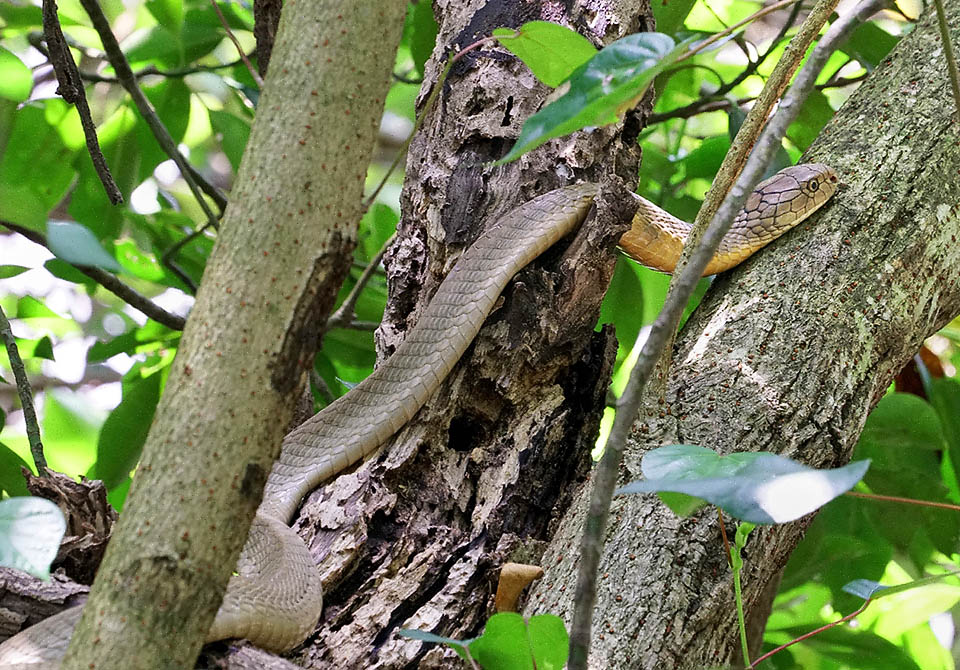
Easily moves on the ground as well as on the trees where it can climb looking for preys up to 20 m of height © Catalina Tong
Although its visual activity in detecting stationary objects is not very developed, this snake is however able to detect preys or possible dangers in movement even from distances close to 100 metres.
It feeds at intervals of 15-20 days, usually after moulting that occurs 7-8 times per year; it never feeds during the reproductive season, but during the monsoon time it can feed more than three times in a week, due to the bigger need of energy during the cooler months.
The period of ingestion of a prey, dead or still alive, may vary from a few minutes tomore than one hour, depending on its size.
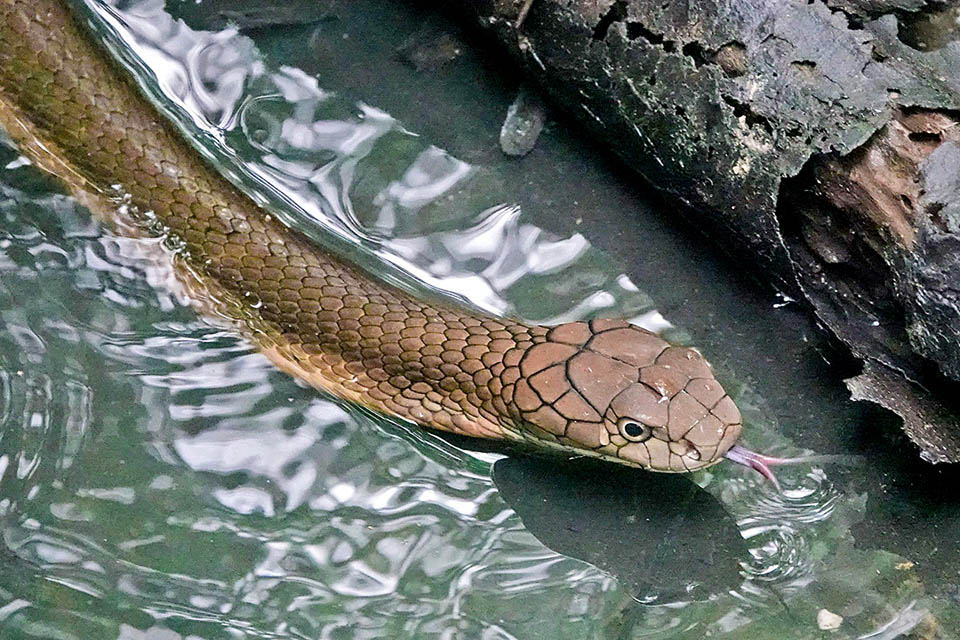
It is also perfectly able to swim and here we note quite well the big occipital scales that distinguish it, plus the rest, from the genus Naja © Soh Kam Yung
Despite its preys being other snakes, the King Cobra is not immune to their venom, and can be even killed by other venomous snakes, including members of its own species.
Are known, in fact, instances of cannibalism, of males on other males as well as of males on females; this last behaviour occurs outside the mating season, as it is assumed that the associated hormones suppress the appetite in males during the reproductive season.
If disturbed, Ophiophagus hannah tends to flee quickly, but if escape is impossible then may get fairly aggressive.
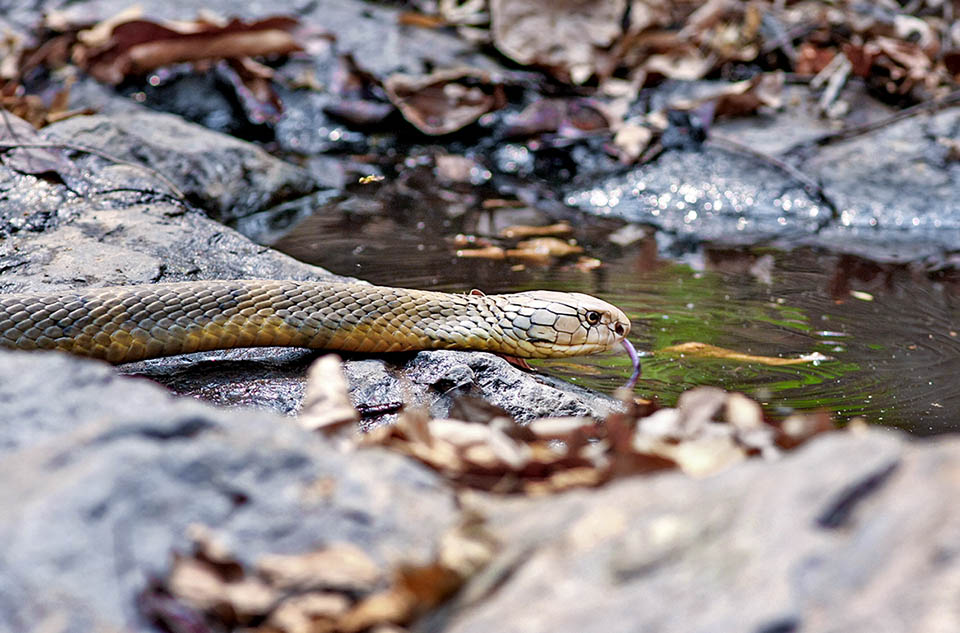
Also in the reproductive period, when Ophiophagus hannah doesn’t eat, it cannot help to drink anyway © Woraphot Bunkhwamdi
In such case it exhibits an emblematic combination of behaviours, morphological and physiological adaptations, that manifest through some defensive and dissuasive strategies, visual and sound, usually preferred to an actual attack, that include: the raising of about one third of the body, even more than one metre from the ground, and its dorso-lateral flattening, the extension of the neck with relevant expansion of the characteristic hood, the display of the ventral colours and of the ornamentation of the bright yellow spotted hood, the exposition of the fangs and the emission of a loud hissing sound, at times with fake closed mouth blows.
The flattening of the body, the expansion of the neck and the oxtentatin of the colours are aposematic adaptations, that is aimed at dissuading possible attackers indicating the possession of particular means of defense.
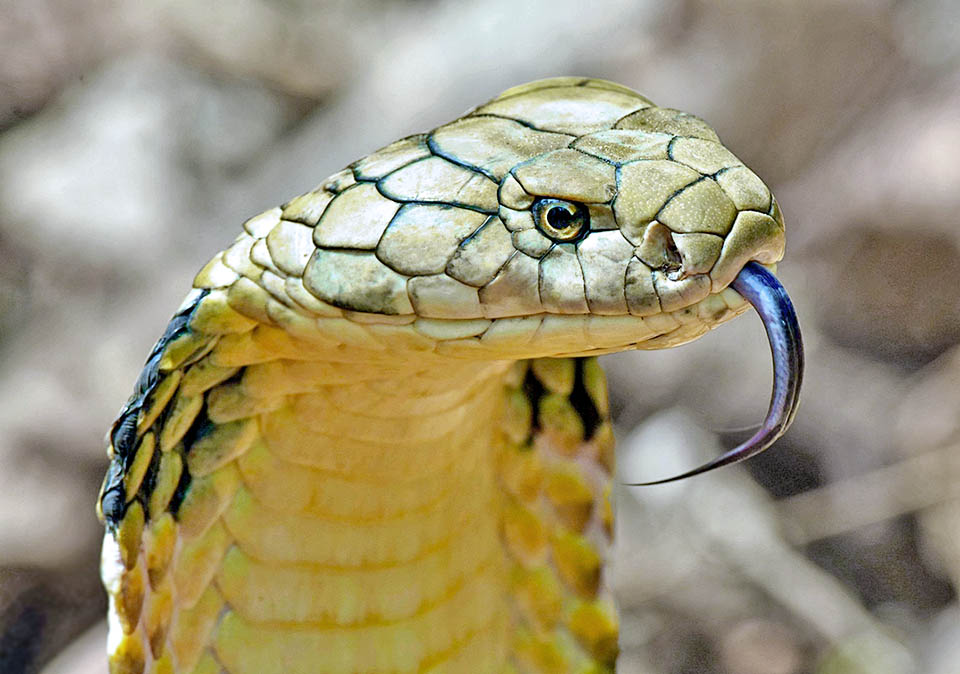
The great forked tongue that King Cobra wags a lot, serves to get information from the environment through the chemical-odorous particles emitted by the preys © Puttaraju Kenchappa
It is worthy to note that the Malayan populations, whose venom is composed of cytotoxins more effective than the other populations present a very flashy bright orange ventral colouration.
Also in a semi-erect position it is able to move towards the aggressor for biting it repeatedly in every single attack, often prologing the bite and injecting a greater quantity of venom. Finally, the sex ratio appears unbalanced in favour of males, by 3:1.
Morphophysiology
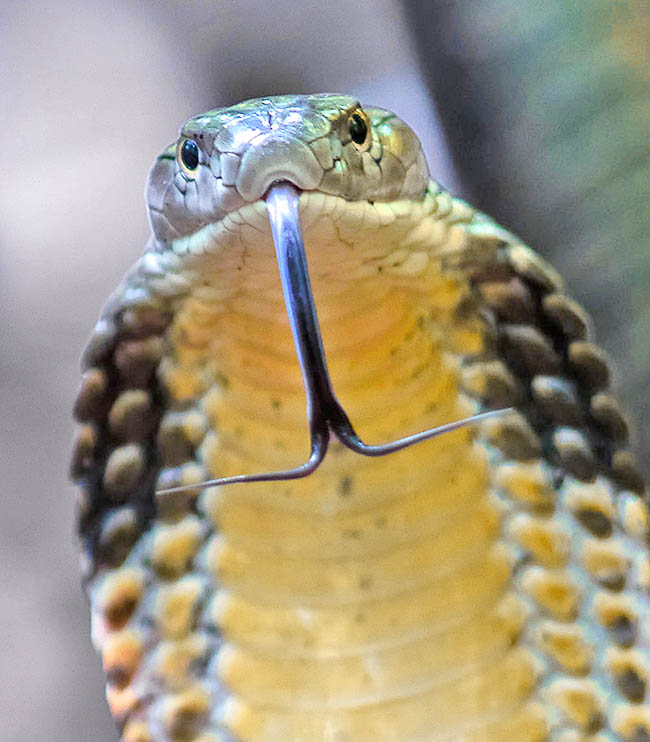
In fact it transfers them to the Jacobson organ, a sensory receptor placed in the upper part of the mouth © Frank Deschandol
As already repeatedly mentioned, Ophiophagus hannah is a big snake that can reach 6 metres, but whose average length is 3-4 m, and of average weight of 6 kg, with peaks of about 12 kg, and with an average life in nature of about 20 years.
It shows considerable variations in colour and pattern, ranging from glossy black, light olive colour, grey, green-brownish, to golden yellow, often with black bands, white or yellow transversal bands also arranged in the shape of an arrow.
The head is black with two bands close to the snout and two behind the eyes, the belly is pale or light yellow. The ventral scales are oval, and the dorsal ones are arranged obliquely.
The males have 235-250 ventral scales, whilst the females have 239-265. The subcaudal are single or coupled on each row, 83-96 in the males and 77-98 in the females. The juveniles are glossy black with thin yellow bands.
The main morphological differences allowing to distinguish the King Cobra from the “true” cobras of the genus
Naja are: bigger in Ophiophagus, wedge-shaped scaled are present in the genus Naja, occipital scales present in Ophiophagus and absent in Naja, narrow and long hood with two rows arranged in the shape of an arrow in the rear and without pattern shaped like glasses in Ophiophagus and wide with eye-shaped design, single or double, in Naja.
Ophiophagus can, moreover, emit a “growling hiss”, of very low frequency: whilst the hisses of most snakes have a vast range of frequencies from about 3000 to 13000 Hz with a dominant frequency close to 7500 Hz, the growl of the King Cobra, made possible by the presence of tracheal diverticula that act as sounding boards, consists exclusively in frequencies below 2500 Hz, with a much lower dominant frequency, around 600 Hz, closer the the human voice.
The adults’ head is massive and bulky , and can expand the jaws in order to swallow large preys.
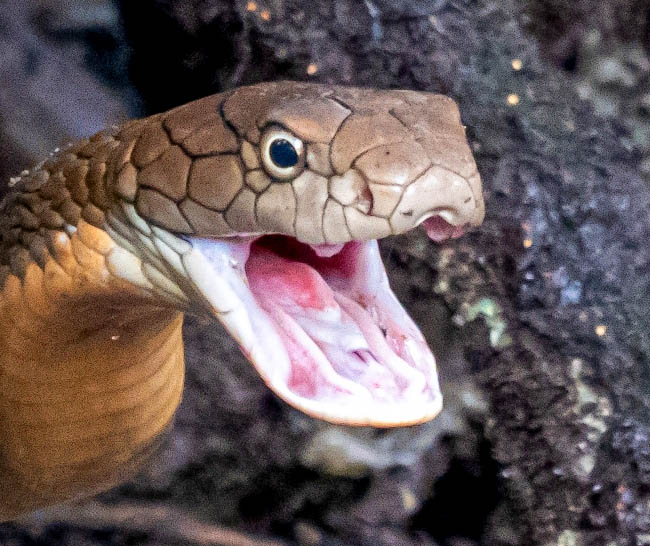
Ophiophagus hannah with a threatening open mouth. The venom teeth are poorly visible, but the quantity of venom at disposal is enormous, as much that it could kill even an adult elephant in a matter of few hours © James Donnelly
It is proteroglyphous, with two short fangs fixed in the fore part of the mouth that inject the venom into the prey like hypodermic needles.
The sexual dimorphism, limited to size and colour, has led the naturalist G. H. Evans, in 1902, to consider the two sexes as different species: the male is averagely bigger than the female, unusual fact as in the other snakes we see normally the opposite: the females, instead, are darker, especially during the reproductive time; the males tend to get darker during the season of the rains, and this with thermoregulation function.
Ophiophagus hannah is a species important from a medical point of view due to the high neurotoxicity of its venom, produced by the suborbital glands.
It is classified by the World Health Organization in category 2 of the venomous snakes, that is a strongly venomous species able to cause a high degree of disease, disability and eventually death, with a poor knowledge of the clinical and epidemiological data.
The King Cobra bite poisoning, that can kill an elephant within a few hours, manifests itself in man with local tissue damages and systemic neurotoxicity: the victims develop commonly, around the affected area, severe pain and swelling that may extend to the entire bitten limb and to the surrounding body structures. In the most serious cases the resulting tissue necrosis needs a surgical intervention that leads to the amputation of the limb. If the bite is not treated properly, neuromuscular paralysis and death by respiratory arrest may follow.
The King Cobra is the only elapid in whose venom have been isolated two enzymes with opposite effects : hannahtoxin with haemorrhagic effects and ophiolysin, coagulant.
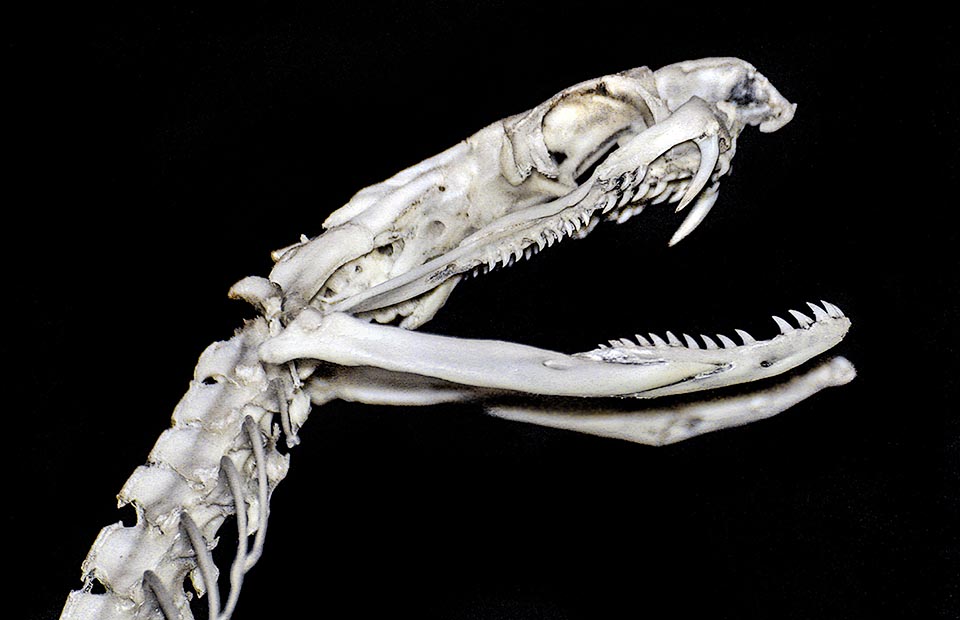
It’s better understood from the skeleton showing rows of sharp teeth for holding and gulping preys and the teeth typical of proteroglyphous snakes. In fact Elapidae have two short and fixed fangs, non-foldable as in Viperidae family, placed in the fore part of the mouth for injecting venom like two hypodermic needles © Mark Witwer
As it is able to inject a huge quantity of venom, more than 1 g of dry substance, is consequently necessary a large quantity of antidote, not always available.
As already previously illustrated, Ophiophagus hannah is a group of cryptic species, and it is possible that such diversity is reflected in the venom composition, influencing the dangerousness of the bite as well as the effectiveness of the antivenom serums.
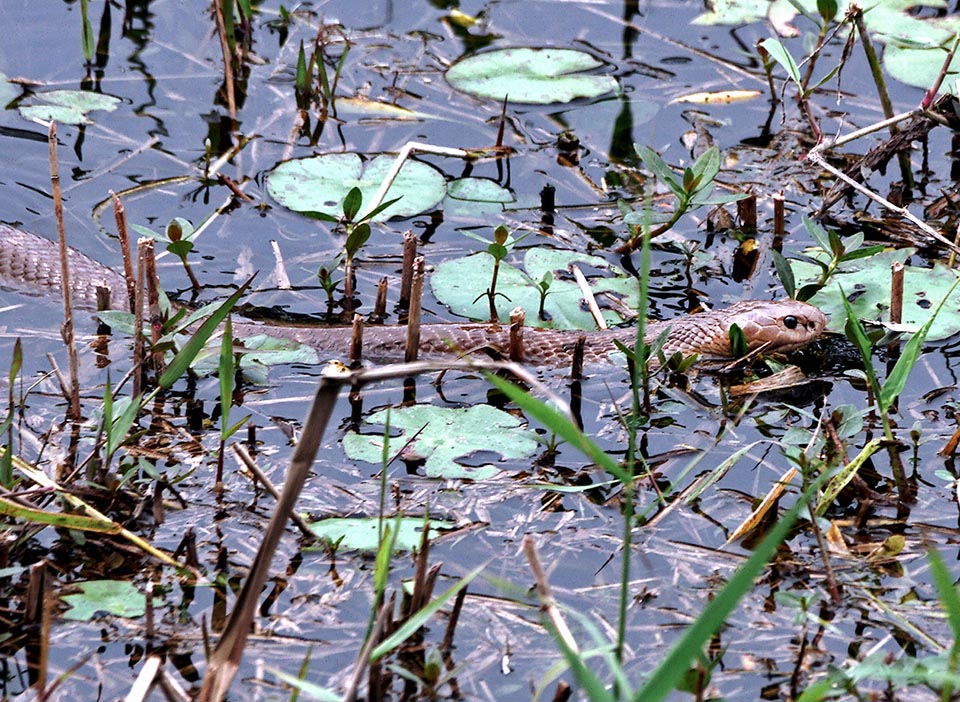
This has smelled the odour of its choice prey, the Oriental rat snake (Ptyas mucosa) and follows it in a marshy swamp © Paul Davis
Exhaustive studies on the composition of the venom of this reptile are still few, in particular those concerning the variability across the vast distribution range of this species.
The only extant antidotes, still of limited availability, have been synthesized in India and in Thailand to neutralize the effects of poisonings caused by the bites of the respective snake populations, but they are not as effective in the bites of the other populations.
The geographical variations in the composition of the venom of this species are presumably due also to the different food preferences relative to available preys: the populations of China, in whose cultivated and rural areas the pest rodents are quite abundant, have a venom more lethal to mammals, whilst the venom of the populations of south-east Asia, that display more markedly ophiophagous habits, appears more effective to other reptiles.
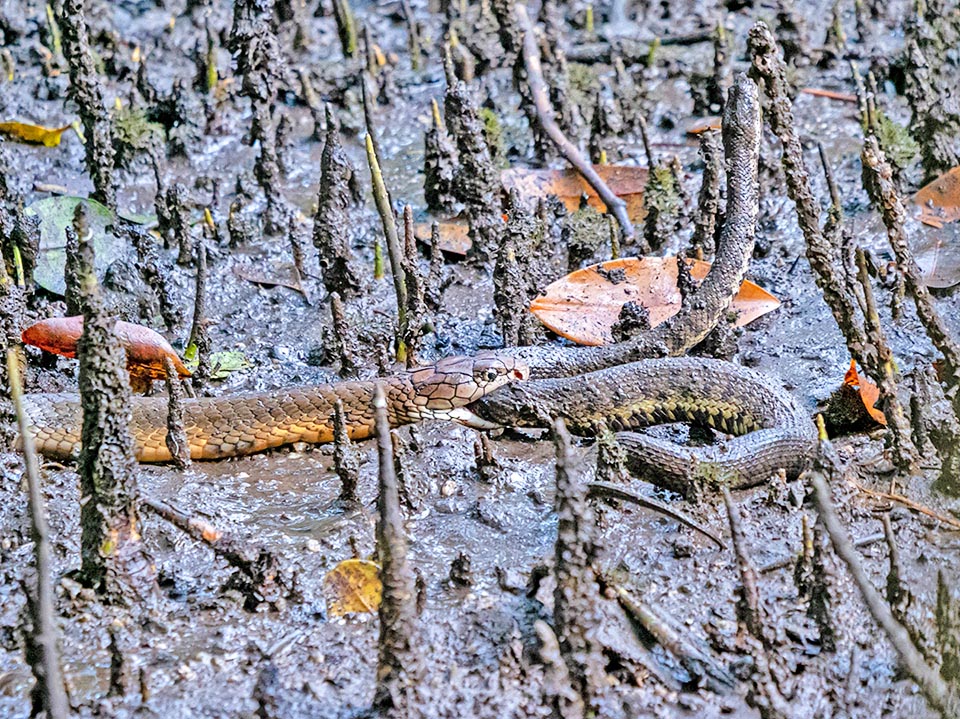
One bite and it is done for. But it eats also big snakes, such as Reticulated python (Malayopython reticulatus) or the Indian rock python (Python molurus) © James Donnelly
Ethology-Reproductive Biology
Ophiophagus hannah is an oviparous species whose males show a greater territoriality and aggressiveness during the reproductive season, usually after the winter, when they engage in fights that rarely end with the death of the opponent.
During this ritual, not lethal but energy demanding, the two males raise the upper part of the body and intertwine with each other without biting but trying to overwhelm the opponent by pushing the rival’s head to the ground to get the right to mate with a receptive female.
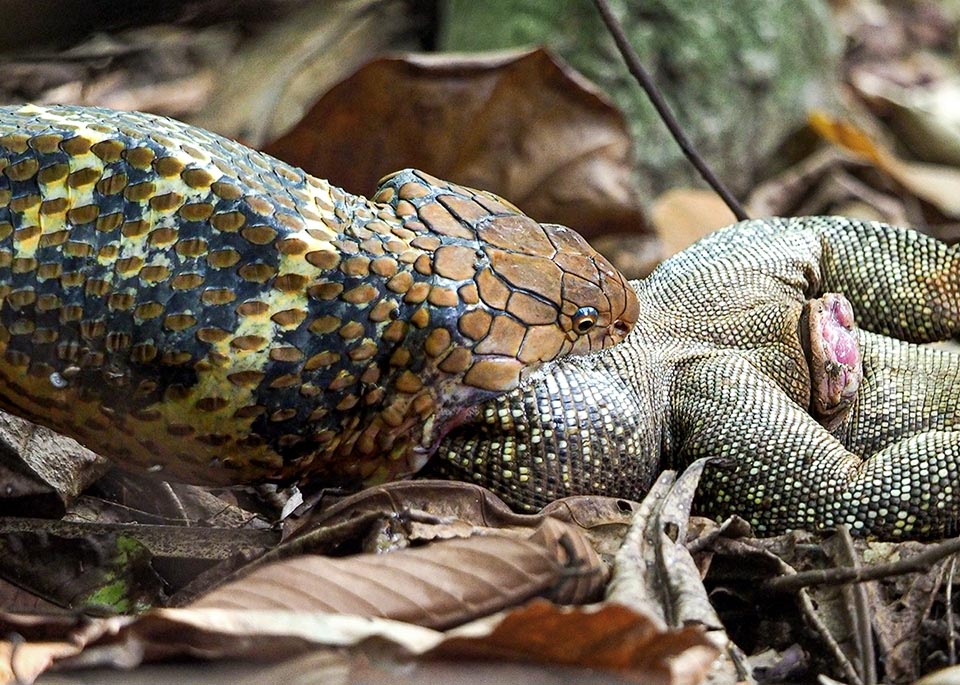
Here gulping down a Varanus. If food is scarce it may attack bird and mammals, but the usual preys are snakes, even conspecific as it is not immune to its venom © James Donnelly
During the courting ritual, which can be started by both sexes and that lasts about 15-20 minutes, the male strikes lightly with the tip of its snout, the hood, the head and the sides of the female who in turn stimulates the male crawling a little further away.
After having been wrapped around the back by the male, who raises the base of her tail, is fecundated through the alternate introduction of the two hemipenes into her reproductive organ; during this last stage, that may last another 15 minutes, the two animals keep practically motionless.
The females of the King Cobra display a unique behaviour among the snakes.
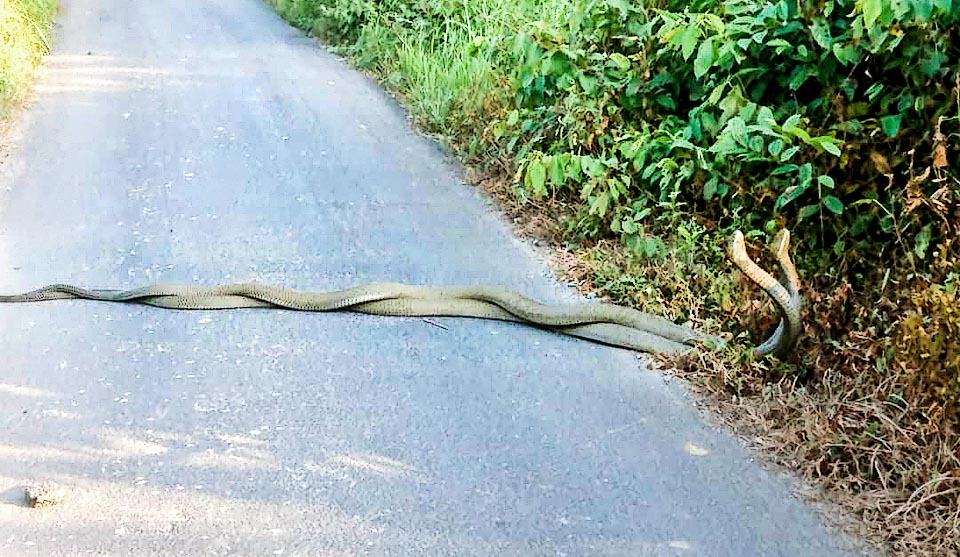
In the males love fights the venom is not however used in the species interest. The two champions intertwine and the strongest wins pushing to the ground the rival head © afighani28
After about 60 days from mating, before ovipositing, they actively build mound-shaped nests on the surface of the soil utilizing leaves of the litter and other vegetal material, and survey them until hatching, attacking, even without provocation, in order to dissuade any predators.
The nests, always near a watercourse, are formed by three layers: the surface layer, protecting from heat and rain, composed of well-compacted plant material; the central, with less compacted plant material, that keeps temperature and humidity more or less constant inside the chamber of deposition; the deposition chamber, well off the ground, where the eggs are incubated.
Throughout the incubation period, the female leaves occasionally the nest for drinking, never for feeding.
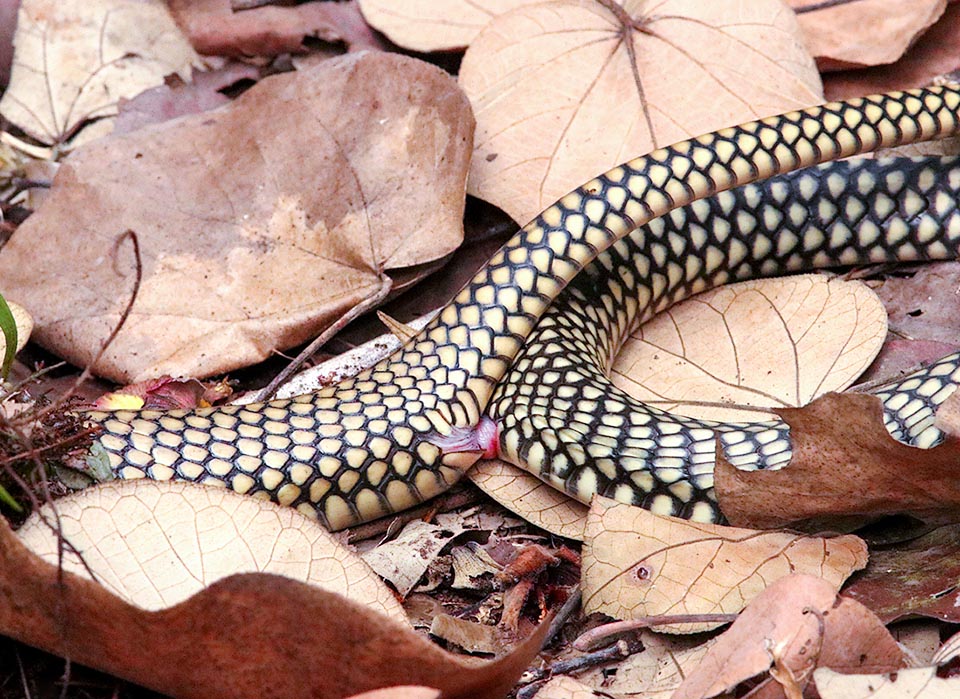
Mating may last even 15 minutes. The male raises the base of the tail of the female and introduces alternatively its two hemipenes into the reproductive organ © Ryan van Huyssteen
Observations carried out on populations of north-eastern India and Myanmar have evidenced the appearance of the nests between the months of April and July, with clutches of 14-53 eggs and relevant hatching after 70-100 days from the deposition.
In the King Cobra has been documented, moreover, the facultative parthenogenesis, that is asexual reproduction through the development of not fecundated eggs.
Ophiophagus hannah is considered “VU, Vulnerable” in the IUCN Red List of the species at risk of extinction: like many other snakes, the King Cobra is hunted, bred and marketed because of its flesh, of the skin and for the its utilization in the traditional medicine, as it is believed to have health benefits, including the relief from fatigue and the increase of virility.
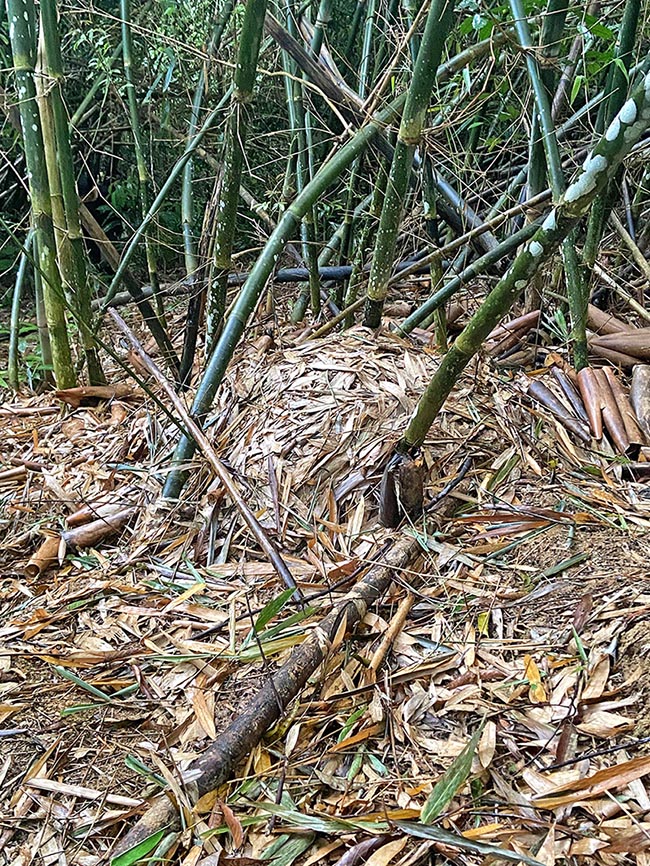
About two months after mating, the female builds up the nest: a well-arranged pile with litter leaves. At the center the incubation chamber, at more or less constant temperature and humidity, where are laid 14-53 eggs © Phan Vũ Phúc Lân
The King Cobra, along with some species of the genus Naja, is of considerable cultural importance in numerous Asian societies in the Hindu culture, i.e. it is considered as a descendant of the Nāga, mythological deities related to water, to fertility and to the underground world, potentially dangerous but more often beneficial, that take on, from time to time, a human or a snake-like appearance.
In Thailand, in the so-called King Cobra Village (Ban Khok Sa-nga), the inhabitants commonly hold a few individuals of this species with whom they perform almost daily propitiatory ritual rites.
An emblematic case of ritual human-snake interaction is given by the Indian ceremonies performed by the Hindu monks Yogi Nath, universally known as snake charmers: once caught a snake, the charmer puts it in a basket, goes to a village, attracts passers-by with the sound of a flute, makes the snake come out of the basket, usually a True Cobra or a King Cobra.
The ability in handling it confers the charmer a particular aspect within the society, as well as representing a more or less profitable remuneration.
The snake utilized in these ceremonies, however, is submitted to significant stress to prevent fatal incidents caused by the bites: at the time of capture to the King Cobra are immediately broken the venom teeth so that they can grow back; then the venom apparatus is severed with a sharp needle, and about 40% the snakes treated in this way report inflammations and oral infections of various nature.
The venom apparatus is not removed permanently due to the big size of the glands: if it were deprived of them, its mouth would appear smaller, thus reducing the terrifying effect this snake has usually on the audience.
Finally, should the King Cobra turn out to be too weak, because of infections and malnutrition, to ensure a satisfying “show”, it is usually released in the natural environment where however it has poor possibilities of survival.
Therefore, it is not astonishing that the use of wild animals for commercial or subsistence purposes by the communities has been deemed illegal in India starting from mid-20h century.
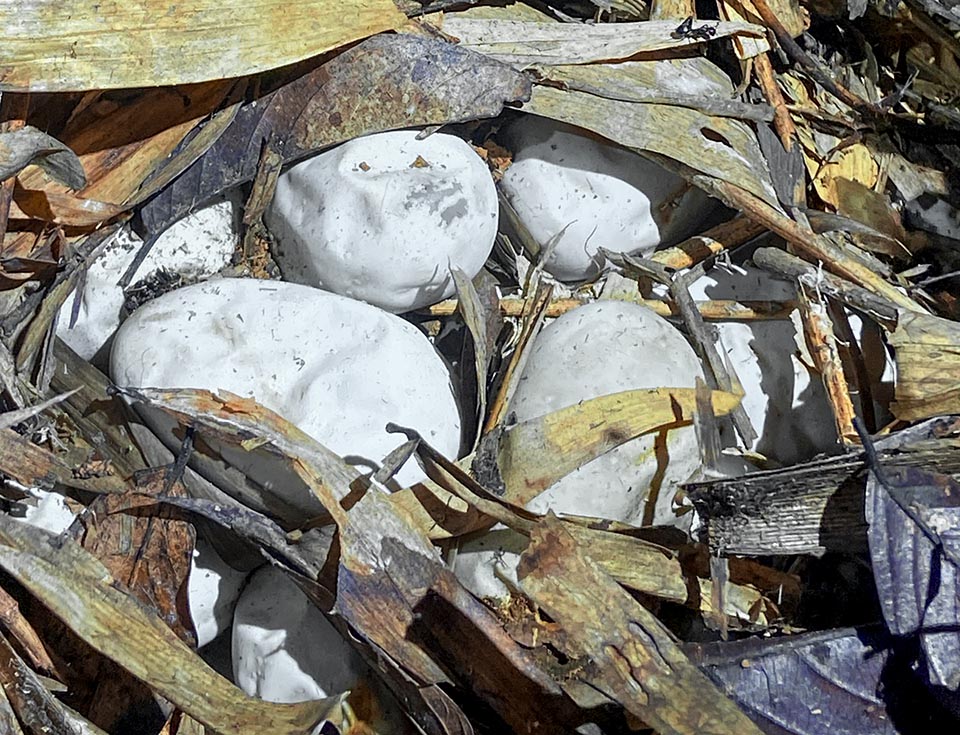
Here are some exposed. while waiting for hatching, that occurs after 70-100 days, the female keeps watch biting the intruders © Phan Vũ Phúc Lân
The interaction between human communities and Ophiophagus hannah is moreover influenced by some environmental and human factors: “global warming”, floods and deforestation contribute to the loss of the natural habitat of this species, whose population density is strongly connected to the presence of undisturbed forest areas.
The landscapes modified by anthropization usually do not support a stable wild fauna, and in this way the possibility is increased that the King Cobra settles in the urban settlements, thus intensifying the man-snake conflicts that often result in the deliberate killings of the encountered reptiles.
In future these factors could become the main causes of poisoning by Ophiophagus hannah, especially in the rural and agricultural areas.
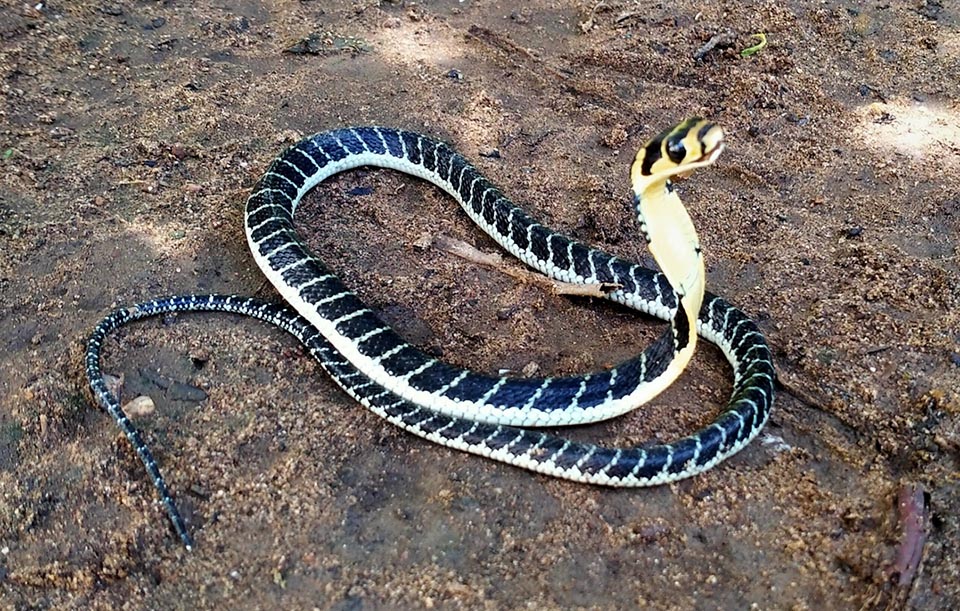
Juvenile. Even if so young it’s completely autonomous and can raise gritty as its parents © Zainudin Basriansyah Akar
Reducing such risks requires a greater public awareness, that foresees the involvement of the local populations, and the use of protective devices in order to reduce to a minimum the possibility of potentially fatal aggressions. To understand the systematics of this iconic taxon is not only important for theoretical reasons, but also for management and conservation purposes.
The groups formed by cryptic species require a special consideration in the planning of their conservation, as the species composing them may be more rare or more localized in respect to the group in its whole.
These different species require individual evaluations of the state of conservation and might need various strategies of conservation.
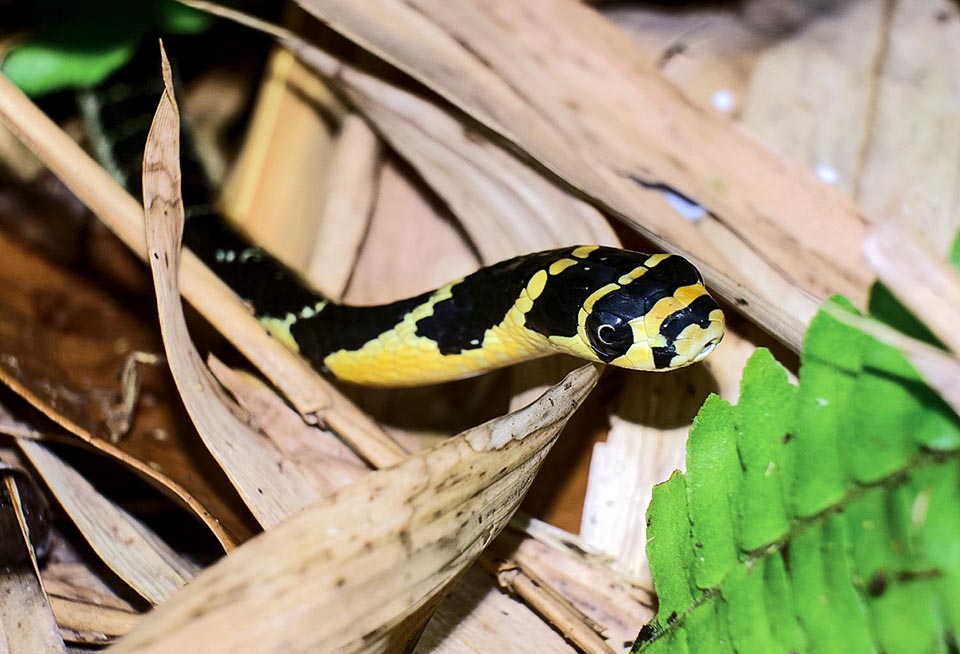
Here explores the litter looking for small preys. Ophiophagus hannah may reach 20 years of age, but stands as “VU, Vulnerable” in the IUCN Red List of the species at risk © ljk1410
Ophiophagus hannah is an apex predator among the snakes, and consequently a suitable indicator of the health of the herpetofauna in its natural habitat. As a flag species, a charismatic animal utilized by the communities to attract attention on a particular environmental problem of the ecosystem, its protection is nowadays imperative and most necessary as ever.
Synonyms
Hamadryas hannah Cantor, 1836; Naja bungarus Schlegel, 1837; Hamadryas ophiophagus Cantor, 1838; Naja vittata Elliott, 1840; Dendraspis bungarus Fitzinger, 1843; Hamadryas elaps Günther, 1858; Ophiophagus elaps Günther, 1864; Naja ingens Van Hasselt, 1882; Naja hannah Taylor, 1922; Ophiophagus hannah Bogert; 1945; Dendraspis hannah hannah Deraniyagala, 1960.
→ For general notions about Serpentes please click here.
→ To appreciate the biodiversity within the SNAKES please click here.
